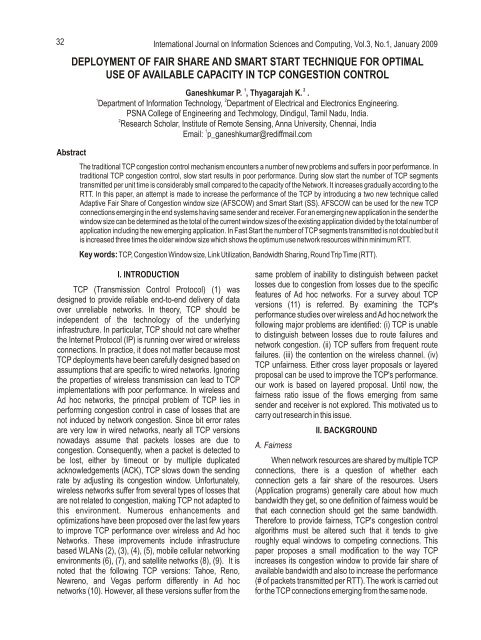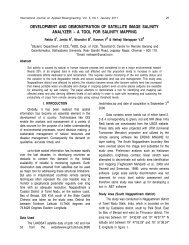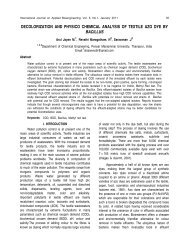Download Full Paper - Sathyabama University
Download Full Paper - Sathyabama University
Download Full Paper - Sathyabama University
Create successful ePaper yourself
Turn your PDF publications into a flip-book with our unique Google optimized e-Paper software.
32 International Journal on , Vol.3, No.1, January 2009<br />
Information Sciences and Computing<br />
DEPLOYMENT OF FAIR SHARE AND SMART START TECHNIQUE FOR OPTIMAL<br />
USE OF AVAILABLE CAPACITY IN TCP CONGESTION CONTROL<br />
Abstract<br />
1 2<br />
Ganeshkumar P. , Thyagarajah K. .<br />
1 2<br />
Department of Information Technology, Department of Electrical and Electronics Engineering.<br />
PSNA College of Engineering and Techmology, Dindigul, Tamil Nadu, India.<br />
2<br />
Research Scholar, Institute of Remote Sensing, Anna <strong>University</strong>, Chennai, India<br />
1<br />
Email: p_ganeshkumar@rediffmail.com<br />
The traditional TCP congestion control mechanism encounters a number of new problems and suffers in poor performance. In<br />
traditional TCP congestion control, slow start results in poor performance. During slow start the number of TCP segments<br />
transmitted per unit time is considerably small compared to the capacity of the Network. It increases gradually according to the<br />
RTT. In this paper, an attempt is made to increase the performance of the TCP by introducing a two new technique called<br />
Adaptive Fair Share of Congestion window size (AFSCOW) and Smart Start (SS). AFSCOW can be used for the new TCP<br />
connections emerging in the end systems having same sender and receiver. For an emerging new application in the sender the<br />
window size can be determined as the total of the current window sizes of the existing application divided by the total number of<br />
application including the new emerging application. In Fast Start the number of TCP segments transmitted is not doubled but it<br />
is increased three times the older window size which shows the optimum use network resources within minimum RTT.<br />
Key words: TCP, Congestion Window size, Link Utilization, Bandwidth Sharing, Round Trip Time (RTT).<br />
I. INTRODUCTION<br />
TCP (Transmission Control Protocol) (1) was<br />
designed to provide reliable end-to-end delivery of data<br />
over unreliable networks. In theory, TCP should be<br />
independent of the technology of the underlying<br />
infrastructure. In particular, TCP should not care whether<br />
the Internet Protocol (IP) is running over wired or wireless<br />
connections. In practice, it does not matter because most<br />
TCP deployments have been carefully designed based on<br />
assumptions that are specific to wired networks. Ignoring<br />
the properties of wireless transmission can lead to TCP<br />
implementations with poor performance. In wireless and<br />
Ad hoc networks, the principal problem of TCP lies in<br />
performing congestion control in case of losses that are<br />
not induced by network congestion. Since bit error rates<br />
are very low in wired networks, nearly all TCP versions<br />
nowadays assume that packets losses are due to<br />
congestion. Consequently, when a packet is detected to<br />
be lost, either by timeout or by multiple duplicated<br />
acknowledgements (ACK), TCP slows down the sending<br />
rate by adjusting its congestion window. Unfortunately,<br />
wireless networks suffer from several types of losses that<br />
are not related to congestion, making TCP not adapted to<br />
this environment. Numerous enhancements and<br />
optimizations have been proposed over the last few years<br />
to improve TCP performance over wireless and Ad hoc<br />
Networks. These improvements include infrastructure<br />
based WLANs (2), (3), (4), (5), mobile cellular networking<br />
environments (6), (7), and satellite networks (8), (9). It is<br />
noted that the following TCP versions: Tahoe, Reno,<br />
Newreno, and Vegas perform differently in Ad hoc<br />
networks (10). However, all these versions suffer from the<br />
same problem of inability to distinguish between packet<br />
losses due to congestion from losses due to the specific<br />
features of Ad hoc networks. For a survey about TCP<br />
versions (11) is referred. By examining the TCP's<br />
performance studies over wireless andAd hoc network the<br />
following major problems are identified: (i) TCP is unable<br />
to distinguish between losses due to route failures and<br />
network congestion. (ii) TCP suffers from frequent route<br />
failures. (iii) the contention on the wireless channel. (iv)<br />
TCP unfairness. Either cross layer proposals or layered<br />
proposal can be used to improve the TCP's performance.<br />
our work is based on layered proposal. Until now, the<br />
fairness ratio issue of the flows emerging from same<br />
sender and receiver is not explored. This motivated us to<br />
carry out research in this issue.<br />
II. BACKGROUND<br />
A. Fairness<br />
When network resources are shared by multiple TCP<br />
connections, there is a question of whether each<br />
connection gets a fair share of the resources. Users<br />
(Application programs) generally care about how much<br />
bandwidth they get, so one definition of fairness would be<br />
that each connection should get the same bandwidth.<br />
Therefore to provide fairness, TCP's congestion control<br />
algorithms must be altered such that it tends to give<br />
roughly equal windows to competing connections. This<br />
paper proposes a small modification to the way TCP<br />
increases its congestion window to provide fair share of<br />
available bandwidth and also to increase the performance<br />
(# of packets transmitted per RTT). The work is carried out<br />
for the TCP connections emerging from the same node.
Ganeshkumar et al : Depolyment of Fair Share and Smart Start Technique for Optimal Use...<br />
proposed system for which the fairness index is 0.9365.<br />
From this it is clear that fairness index of proposed system<br />
is higher than that of existing system.<br />
IV. Simulation and Results<br />
The proposed technique is implemented in ns2 Simulator.<br />
Performance of the TCP is compared with the proposed<br />
technique and existing scheme. Number of node is taken as<br />
30. The TCP statistics for a simulation run of 100 seconds<br />
time period, number of nodes 30, Node placement –<br />
Uniform, Mobility Random way point. Free space<br />
propagation is used Source and destination pair is<br />
considered as node 5 and node 25 respectively. Channel<br />
capacity is chosen as 2 Mbit/sec. Dynamic source routing<br />
and IEEE 802.11a is used as the routing and MAC protocol.<br />
FTP is used as the application layer protocol. Packet size of<br />
512, 1024, 2048 bytes are used. Simulation is conducted for<br />
100 seconds. 10 simulation runs are made and the average<br />
value is taken as the data point for result. The comparison<br />
between the existing and proposed technique is shown in<br />
the pie chart in Fig. 1 and 2.<br />
Proposed system<br />
1.02<br />
1<br />
0.98<br />
0.96<br />
0.94<br />
0.92<br />
0.9<br />
0.88<br />
0.86<br />
0.84<br />
Link Utilisation Existing system<br />
Link Utilisation Chart<br />
512 1024<br />
Sement Size<br />
2048<br />
Fig. 1. Link Utilization Chart<br />
Comparison of Fairness Index<br />
Proposed System<br />
1<br />
0.98<br />
0.96<br />
0.94<br />
0.92<br />
0.9<br />
0.88<br />
0.86<br />
0.84<br />
0.82<br />
0.8<br />
Fairness Index Existing System<br />
Based<br />
on Rtt<br />
Based<br />
on Load<br />
Fig. 2. Comparison of Fairness Index.<br />
Link utilization = offered load/ maximum capacity. Link<br />
utilization is computed for packet size of 512, 1024, and<br />
2048 bytes. If the link utilization is 1 then, the capacity of<br />
the link is used efficiently to 100 percentage. In the link<br />
utilization chart it can be seen that the link utilization of<br />
proposed system is greater than that of proposed system.<br />
Fairness index comparison chart reveals that the fairness<br />
ratio of proposed system is greater than that of existing<br />
system. Therefore the simulation result shows the same<br />
result with that of the numerical example discussed in<br />
section 3.<br />
V. Smart Start (SS)<br />
The slow start and congestion avoidance algorithms<br />
must be used by a TCP sender to control the amount of<br />
outstanding data being injected into the network. To<br />
implement these algorithms, two variables are added to<br />
the TCP per-connection state. The congestion window<br />
(cwnd) is a sender-side limit on the amount of data the<br />
sender can transmit into the network before receiving an<br />
acknowledgment (ACK), while the receiver's advertised<br />
window (rwnd) is a receiver-side limit on the amount of<br />
outstanding data. The minimum of cwnd and rwnd<br />
governs data transmission. In slow start after, the first<br />
successful transmission and acknowledgement of a TCP<br />
segment increases the window to two segments. After<br />
successful transmission of these two segments and<br />
acknowledgements completes, the window is increased to<br />
four segments. Then eight segments, then sixteen<br />
segments and so on, doubling from there on out up to the<br />
maximum window size advertised by the receiver or until<br />
congestion finally does occur. In slow start even though,<br />
the window size is increased faster the connection takes<br />
much long time to reach the maximum utilization of<br />
bandwidth available in the link. To overcome this, a<br />
procedure such as increasing the window size either in the<br />
multiples of 3 or 4 is proposed rather than increasing the<br />
window size in multiples of 2 for each acknowledgement.<br />
A. Assumptions<br />
RTT=500 unit, Acknowledgement is received for each<br />
RTT, Bandwidth used is calculated by Used bandwidth =<br />
Sender Window size (SWS) * 3. The units of all the<br />
parameter are treated as general (it may be ms for RTT, #<br />
of bytes for Sender Window size, Kbps/Mbps for Used<br />
Bandwidth)<br />
In the table 5 sender window size is increased by 2 for each<br />
RTT ie) Sender Window Size = Previous Sender Window<br />
Size *2. if the unit of RTT is considered as ms, then from<br />
the table it can be proved that that it takes 8 seconds till the<br />
TCP flow reaches 100MB/s at a RTT of 500ms.<br />
35
36 International Journal on , Vol.3, No.1, January 2009<br />
Information Sciences and Computing<br />
SI.No. Time<br />
(RTT)<br />
Table 5. SWS in Multiples of 2<br />
Sender Window<br />
Size<br />
Table 6. SWS in Multiples of 3<br />
Used<br />
Bandwidth<br />
1 0 1 3<br />
2 500 2 6<br />
3 1000 4 12<br />
4 1500 8 24<br />
5 2000 16 48<br />
6 2500 32 96<br />
7 3000 64 192<br />
8 3500 128 384<br />
9 4000 256 768<br />
10 4500 512 1536<br />
11 5000 1024 3072<br />
12 5500 2048 6144<br />
13 6000 4096 12288<br />
14 6500 8192 24576<br />
15 7000 16384 49152<br />
16 7500 32768 98304<br />
17 8000 65536 196608<br />
SI.No. Time Sender Window Used<br />
(RTT) Size<br />
Bandwidth<br />
1 0 1 3<br />
2 500 3 9<br />
3 1000 9 27<br />
4 1500 27 81<br />
5 2000 81 243<br />
6 2500 243 729<br />
7 3000 729 2187<br />
8 3500 2187 6561<br />
9 4000 6561 19683<br />
10 4500 19683 59049<br />
11 5000 59049 177147<br />
In the table 3 sender window size is increased by 3 for each<br />
RTT ie) Sender Window Size = Previous Sender Window<br />
Size *3. If the unit of RTT is considered as ms, then from<br />
the table it can be proved that that it takes 5 seconds till the<br />
TCP flow reaches 100MB/s at a RTT of 500ms.In the table<br />
7 sender window size is increased by 4 for each RTT ie)<br />
Sender Window Size = Previous Sender Window Size *4.<br />
If the unit of RTT is considered as ms, then from the table it<br />
can be proved that that it takes 4 seconds till the TCP flow<br />
reaches 100MB/s at a RTT of 500ms.<br />
Table 7. SWS in Multiples of 4<br />
SI.No. Time Sender Window Used<br />
(RTT) Size<br />
Bandwidth<br />
1 0 1 3<br />
2 500 4 12<br />
3 1000 16 48<br />
4 1500 64 192<br />
5 2000 256 768<br />
6 2500 1024 3072<br />
7 3000 4096 12288<br />
8 3500 16384 49152<br />
9 4000 65536 196608<br />
Table 8. Comparison of Time Vs SWS of 2,3,4.<br />
SI.No SWS ^ Time *<br />
1 2 8<br />
2 3 5<br />
3 4 4<br />
SWS^ represents the magnitude at which the sender<br />
window size is increased.<br />
Time * represents the maximum time taken by the<br />
connection to attain 100Mbps<br />
By examining the data's given in table 8, it can be<br />
understood that, if the sender window size is increased in<br />
multiples of 3 0r 4 then the connection can attain the<br />
maximum link utilization in 3 or 4 times faster than that of<br />
the existing system.<br />
VI. Conclusion<br />
In this paper, we have presented a new technique called<br />
Adaptive Fair Share of Congestion window size<br />
(AFSCOW) for TCP to speed up short transfers such as<br />
web page downloads. Another technique called Smart<br />
Start (SS) technique is used to speed up the sending rate<br />
of the sender TCP to optimally use the available capacity<br />
of the link. These techniques enable the TCP connection to<br />
reduce the overhead of slow start by increasing the<br />
congestion window size fastly. It allows to increase the use<br />
of capacity in network to a optimum level. The key results<br />
are: Large improvements in the utilization of network<br />
bandwidth, improvement of TCP performance (Number of<br />
transmitted segments divided by RTT), Fair sharing of<br />
bandwidth related to the application which belongs to the<br />
same sender and receiver, before the references.
Ganeshkumar et al : Depolyment of Fair Share and Smart Start Technique for Optimal Use...<br />
[1]<br />
REFERENCES<br />
Transmission Control Protocol, 1981 RFC 793<br />
[2] L. Andrew, S. Hanly, and R. Mukhtar, 2003,<br />
CLAMP: Differentiated capacity allocation in<br />
[3]<br />
access networks, in Proc. of IEEE International.<br />
Performance Computing and Communications<br />
Conf., Phoenix,AZ, USA, pp. 451–458.<br />
H. Balakrishnan, V. Padmanabhan, S. Seshan, and<br />
R. Katz, 2006, A comparison of mechanisms for<br />
improving TCP performance overwireless links,<br />
IEEE Transactions on Networking, vol. 5, no. 6, pp.<br />
756–769.<br />
[4] H. Balakrishnan, S. Seshan, E. Amir, and R. Katz,<br />
1995, Improving TCP/IP performance over<br />
wireless networks, in Proc. of ACM MOBIHOC,<br />
Berkeley, CA, USA, , pp. 2–11.<br />
[5] A. V. Bakre and B.R. Badrinath, 1997<br />
[6]<br />
“Implementation and performance evaluation of<br />
indirect TCP,” IEEE Transactions on Networking,<br />
Vol. 46, no. 3, pp. 260–278<br />
K. Brown and S. Singh, 1997, M-TCP: TCP for<br />
mobile cellular networks,” ACM SIGCOMM<br />
[7]<br />
Computer Communication Review, vol. 27,no. 5,<br />
pp. 19–43.<br />
H. Balakrishnan, S. Seshan, and R. Katz, 1995,<br />
Improving reliable transport and handoff<br />
[8]<br />
performance in cellular wireless networks,” ACM<br />
Wireless Networks, vol. 1, no. 4, pp. 469–481.<br />
Y. Tian, K. Xu, and N. Ansari, 2005, TCP in wireless<br />
environments: problems and solutions," IEEE<br />
Communications Magazine , vol. 43, no. 3, pp.<br />
S27-S32.<br />
[9] J.-Y. L. Boudec, 2005, Rate adaptation, congestion<br />
control and fairness: a tutorial.<br />
[10]<br />
http://ica1www.epfl.ch/ PS_files/LEB3132.pdf.<br />
Z. Fu, P. Zerfos, H. Luo, S. Lu, L. Zhang, and M.<br />
Gerla, 2003, The impact of multihop wireless<br />
channel on TCP throughput and loss, in<br />
[11]<br />
Proceedings of the 22nd Annual Joint Conference<br />
on the IEEE Computer and Communications<br />
Societies (INFOCOM '03), vol. 3, pp. 1744-1753,<br />
San Francisco, Calif, USA.<br />
Luqing Yang , Winston K.G. Seah , Qinghe Yin,<br />
2003 ,Improving fairness among TCP flows<br />
crossing wireless ad hoc and wired networks,<br />
Proceedings of the 4th ACM international<br />
symposium on Mobile ad hoc networking &<br />
computing, pp 171-179 , Annapolis, Maryland,<br />
USA.<br />
Ganeshkumar P.<br />
Research scholar - Anna <strong>University</strong>,<br />
Chennai. He is a member of IEEE ,<br />
ISTE and CSI. He had published<br />
several papers in International<br />
journals, IEEE international<br />
conferences and national<br />
conferences. Currently he is working<br />
as assistant professor in PSNA College of Engineering<br />
and Technology. His area of interest includes Distribution<br />
systems, Computer Network andAd hoc Network.<br />
37









